|
|

Hotels and Resorts | Jammu Kashmir Tours
Jammu and Kashmir are really three
regions: the foothill plains of Jammu; the lakes and blue valleys of Kashmir
rising to alpine passes, the high altitude plains and starkly beautiful
mountains of Ladakh which lies beyond those passes. It's enough to move you to
poetry. Srinagar is Kashmir's summer capital and Jammu, the winter capital.
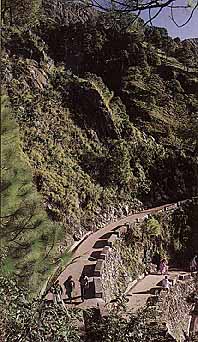
One of Kashmir's greatest attractions
are the Dal
Lake houseboats. The Mughal Gardens of Srinagar
is another tourist haunt. Pahalgam, Gulmarg,
near Srinagar are picturesque towns, the first a by-route to Amarnath, the
second a premier skiing resort. The famous Shankaracharya temple is
perched high on top of the valley. Jammu
is a templed town. Ladakh, the land of high passes, draws tourists to
its Hemis Gompa, Stok Palace and MuseumCapital:
Srinagar, the capital, has a distinctly Central Asian look. It stands on the Dal
Lake ( most of the more modern houseboats are located here) and the picturesque
Jhelum River. Srinagar is also considered to be a small-sized Lake District. The
massive Dal Lake, near the city and Nagin, the 'Jewel in the ring', a smaller
lake, to the north, is dotted with water lilies. The lakes are mobile shops of
moving shikaras. The old city has a labyrinth of alleyways and mosques.
Srinagar
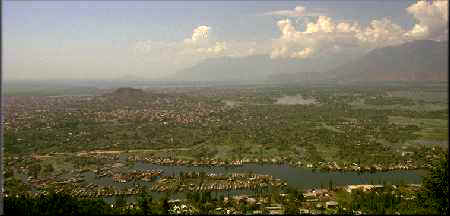
The capital, has a distinctly Central
Asian look. It stands on the Dal Lake ( most of the more modern houseboats are
located here) and the picturesque Jhelum River. Srinagar is also considered to
be a small-sized Lake District. The massive Dal Lake, near the city and Nagin,
the 'Jewel in the ring', a smaller lake, to the north, is dotted with water
lilies. The lakes are mobile shops of moving shikaras. The old city has a
labyrinth of alleyways and mosques.Srinagar is a unique city because of its
lakes - the Dal, Nagin and Anchar. The river Jhelum also flows through a part of
the city.
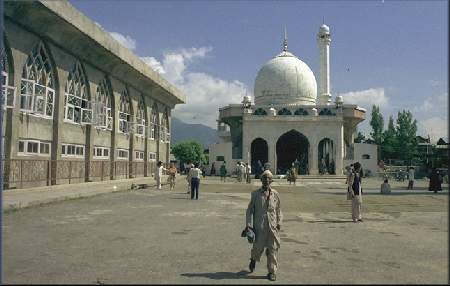
The Dal, Srinagar's largest lake, has
the most numb of houseboats, followed by the Nagin and the Jhelum. As a general
rule, houseboats in the Dal are of all categories, from deluxe through to D
class, while those in the Nagin are largely luxury class and those in the Jhelum
largely economy class. This, however, is a generalization.
Festivals: Jammu celebrates Lohri and Baisakhi in February. The
3-day Jammu Crafts Mela is organised during Baisakhi every year at the
picturesque Mansar Lake, 60 km from Jammu. Bahu Mela, a major festival is held
at the Kali temple in Bahu Fort (Jammu), twice a year during March-April and
September-October. In Srinagar, besides Id other important festivals are Urs at
Khaneka in downtown Srinagar and Urs at Chrar-e-Sharif. The annual Ladakh
festival is held in September; the Hemis Festival features chaams danced
by monks in elaborate masks.
Mughal Gardens :
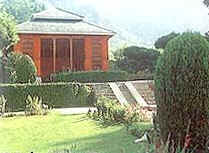
Kashmir was a favourite of the Mughal emperor who visited it as often as they
could. Cool and refreshing after the plains of North India where the business of
governance kept them, they planted gardens with stepped terraces and flowing
water courses. When they rested in their gardens, they dreamt they were in
paradise. Cheshmashahi is the first Mughal garden you will pass after Nehru
Park. Built at a height above the city, its views are as stupendous as its
layout. The smallest of Srinagar's Mughal gardens, Cheshmashahi has only three
terraces in addition to a natural spring of water enclosed in a stone pavilion.
The next garden along the road that encircles the Dal is the Nishat, built by
Empress Nur Jahan's bother Asaf Khan. The largest of the gardens, Nishat has
several terraces, a central water course and a majestic site between the Dal and
the Zabarwan hills.
The third Mughal garden - the Shalimar
- was planted by Jehangir, the Mughal emperor, whose love for Kashmir was
legendary. Shaded by magnificent chinar trees, the Shalimar is a series of stone
pavilions and flowing water with paint - box bright flower beds.
Across the Dal from Shalimar is the mosque of Hazrat bal, the only one of its
kind architecturally in Kashmir. Made of white marble with a dome and a minaret,
Hazrat bal is the repository of a single hair of the Prophet Mohammed, exhibited
to the public on certain days of the year.
PATNITOP
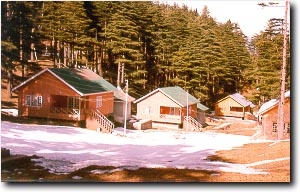 112
kms from Jammu. This famous hill resort is perched on a beautiful plateau, at an
altitude of 2024 metres across which the Jammu-Srinagar Highway passes. Enveloped
by thickly wooded forests, Patnitop offers beautiful picnic spots,
peaceful walks and breathtaking views of the mountainscape of the
Chenab basin. In winter, the resort is generally covered with a thick
mantle of snow thusproviding opportunities for various snow games
including skiing. It is the best developed tourist spot of Jammu and is
second to none in its natural charm, climate, pine forests and lush green cover.
The occupancy of the huts and Dak Banglow is full in summer months. There is
ambitious plan of Patnitop Development Authority to develop Patnitop, Kud,
Sud-Mahadev, Mantalai circuit. The costruction work of Mall Road at Kud is also
proposed to be taken up. Trekking route from Kud to Patnitop-Sanasar has already
been completed. The complete tourist circuit covers Jammu-Katra-VaishnoDeviji,
Kud-Sanasar, Patnitop-Gourikund, Sudmahadev, Mantali, extending upto Latti-Dhuna. 112
kms from Jammu. This famous hill resort is perched on a beautiful plateau, at an
altitude of 2024 metres across which the Jammu-Srinagar Highway passes. Enveloped
by thickly wooded forests, Patnitop offers beautiful picnic spots,
peaceful walks and breathtaking views of the mountainscape of the
Chenab basin. In winter, the resort is generally covered with a thick
mantle of snow thusproviding opportunities for various snow games
including skiing. It is the best developed tourist spot of Jammu and is
second to none in its natural charm, climate, pine forests and lush green cover.
The occupancy of the huts and Dak Banglow is full in summer months. There is
ambitious plan of Patnitop Development Authority to develop Patnitop, Kud,
Sud-Mahadev, Mantalai circuit. The costruction work of Mall Road at Kud is also
proposed to be taken up. Trekking route from Kud to Patnitop-Sanasar has already
been completed. The complete tourist circuit covers Jammu-Katra-VaishnoDeviji,
Kud-Sanasar, Patnitop-Gourikund, Sudmahadev, Mantali, extending upto Latti-Dhuna.
PILGRIMAGES
Vaishno Devi

Faith has moved mountains. From a cave shrine tucked away deep in the the
Trikuta Mountains of Kashmir to a bustling religuous centre, the call of Mata
Vaishno Devi has drawn and converted many a non-believer. Those who come as
tourists leave as staunch followers singing her praises. This is the ultimate
refuge of the helpless. The one place that answers your prayers. Where all
dilemas are resolved. So come with faith - that's all that is asked of you.
Location: The holy cave shrine of Vaishno Devi is nestled in
a beautiful recess of the Trikuta Mountains forming a part of the lower
Himalayas. It is located 61 km north of Jammu at a height of 5,200 feet above
the sea level in the state of Jammu and Kashmir. In the cave there are images of
three deities viz. the Mahakali, Mahalakshmi and Mahasaraswati.
Season: The shrine is visited all through the year, but the
path is difficult during the winters when the route is often blocked by
snow-fall.
Hazratbal
Shrine
The Hazratbal Shrine, which is situated on
the left bank of the famous Dal Lake in Srinagar. This unmatched reverence is
anchored in the love and respect for the Prophet Mohammad(peace be upon him),
whose Moi-e-Muqqadas, (the sacred hair) is preserved here. The shrine is known
by many names including Hazratbal , Assar-e-Sharief, madinat-us-Sani,Dargah
Sharief and Dargah.Sadiq Khan,laid out a garden here and constructed a palacial
building,Ishrat mahal or Pleasure House, in 1623. The construction of the
present marble structure was started by the Muslim Aquaf Trust headed by Sheikh
Mohammad Abdullah in 1968 and completed in 1979.The Moi-e-Muqqadas is displayed
on various occasions related with the life of the Prophet and his four holy
companions.
Shankarcharya
Temple
Shankarcharya Temple is located at
1100ft.above surface level of the main city on the Shankaracharya hill, also
known as Takht-e-Suleiman. The shiva temple, as Kalhana belives, was constructed
by Raja Gopadatya in 371 B.C.and as such is the oldest shirne in Kashmir. Dogra
ruler,Maharaja Gulab Singh, constructed stone stairs upto the temple. In
1925,the temple was electrifed. The temple, besides a prominent religious place
of Hindus, is of great archaeological importance. The temple commands a
magnificient panoramic view of the Srinagar city.
Top
|
|



